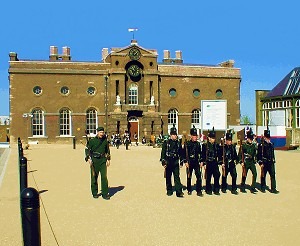|
|
 |
|
Greenwich
|
 |
|
A historic naval town, now much altered, situated three miles east of Greenwich. A community has existed on the riverside at Woolwich since at least the Iron Age and the Romans built a fort here. The Old
English place name probably means ‘trading place for wool’, but no evidence has been found of a wool market. Henry VIII
initiated shipbuilding here and the town’s military facilities subsequently expanded to fill the entire waterfront,
while pottery, glass, bricks and tiles were produced inshore. In 1695 the Royal Laboratory was established next to Tower Place.
The laboratory manufactured explosive armaments and was the precursor of the Royal Arsenal. A burst of activity from 1716
to 1720 saw the construction of a brass foundry, the barracks, a new mansion house and the ‘great pile’ of buildings
at Dial Square – which was probably the work of Nicholas Hawksmoor. The town was soon entirely built up, except for the common, which was used for artillery practice. Shops lined the main
streets and Woolwich became north Kent’s principal commercial centre. Such was the pressure of expansion that growth
began to spill into Plumstead in the nineteenth century and later into Eltham. But the dockyard closed in 1869 and the academy
relocated to Sandhurst in 1947. The arsenal ceased manufacturing in 1967 and closed altogether in 1994. These events brought
a period of decline to Woolwich from which it is only now recovering. Woolwich is touted by some property consultants as south
London’s ‘next big thing’, because of its improving transport links, the developments on the Royal Arsenal
site and a selection of well-built Georgian terraces.
|
 |
|
|
|
 |

|
| Costumed volunteers marching out of step at Woolwich Arsenal |
In the IRA’s Woolwich pub bombing of November 1974 two died and many more were injured when a device was hurled through
the window of the King’s Arms, opposite the Royal Artillery Barracks.
In 1975 Woolwich acquired the UK’s first McDonald’s hamburger restaurant, which took the place of a branch of Burton’s, the tailors. The Woolwich Building Society, founded
in 1847, moved its headquarters to Bexleyheath in 1989.
|
 |
|
|
|
|
|
Postal district: SE18
Population: 27,734 (wards of Woolwich Common and Woolwich Riverside)
Stations: South Eastern (Woolwich Dockyard, zone 3, and Woolwich Arsenal, zone 4)
Further reading: John Peters, Woolwich Remembered, John Manning Peters, 2002
Chambers London Gazetteer has separate entries for Woolwich, Woolwich Arsenal, Woolwich Common and Woolwich Dockyard
Text and selected images are reproduced with the permission
of Chambers but may differ from the published versions
All content © 2005–2010
|
|
|
 |

